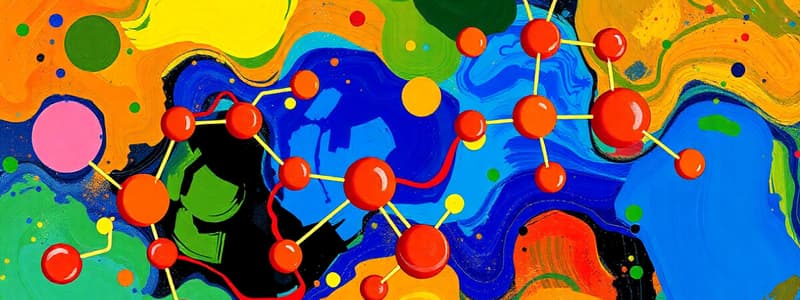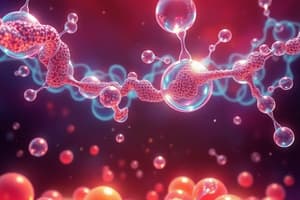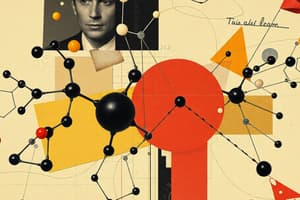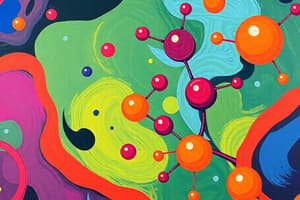Podcast
Questions and Answers
Which of the following describes lipids?
Which of the following describes lipids?
- Composed only of carbon atoms
- Hydrophobic hydrocarbons (correct)
- Made up of monomer units
- Polar and soluble in water
Triglycerides consist of one glycerol molecule and three fatty acids.
Triglycerides consist of one glycerol molecule and three fatty acids.
True (A)
What determines whether fats are solid or liquid at room temperature?
What determines whether fats are solid or liquid at room temperature?
The presence of saturated or unsaturated fatty acids.
Lipids are primarily composed of __________ and __________ atoms.
Lipids are primarily composed of __________ and __________ atoms.
Match the following types of lipids with their characteristics:
Match the following types of lipids with their characteristics:
What is the maximum number of covalent bonds that a carbon atom can form?
What is the maximum number of covalent bonds that a carbon atom can form?
Pure hydrocarbons are polar molecules.
Pure hydrocarbons are polar molecules.
What element is considered the chemical basis of all life?
What element is considered the chemical basis of all life?
The type of bonds that carbon can form, depending on the bonding partner's electronegativity, are called _____________ covalent bonds.
The type of bonds that carbon can form, depending on the bonding partner's electronegativity, are called _____________ covalent bonds.
Match the following types of organic molecules with their characteristics:
Match the following types of organic molecules with their characteristics:
Which of the following is a characteristic feature of carbon that makes it unique?
Which of the following is a characteristic feature of carbon that makes it unique?
Hydrophobic molecules are poorly soluble in water.
Hydrophobic molecules are poorly soluble in water.
What type of structure do pyrimidines, such as cytosine and thymine, have?
What type of structure do pyrimidines, such as cytosine and thymine, have?
DNA is composed of a single strand of nucleotides.
DNA is composed of a single strand of nucleotides.
What sugar is found in RNA nucleotides?
What sugar is found in RNA nucleotides?
In DNA, adenine (A) pairs with ________.
In DNA, adenine (A) pairs with ________.
Match the following nitrogenous bases with their corresponding pairs:
Match the following nitrogenous bases with their corresponding pairs:
Which statement is true about RNA?
Which statement is true about RNA?
The structure of RNA and DNA is identical except for the nitrogenous bases.
The structure of RNA and DNA is identical except for the nitrogenous bases.
What is the shape of the DNA molecule?
What is the shape of the DNA molecule?
The acronym 'Py' in pyrimidines stands for _____ pie.
The acronym 'Py' in pyrimidines stands for _____ pie.
What is a functional group?
What is a functional group?
Which of the following is not a function of proteins?
Which of the following is not a function of proteins?
Dehydration reactions add a molecule of water to form polymers.
Dehydration reactions add a molecule of water to form polymers.
What process involves adding water to break down a polymer?
What process involves adding water to break down a polymer?
Polymers are formed by __________ reactions.
Polymers are formed by __________ reactions.
Match the following types of carbohydrate molecules with their descriptions:
Match the following types of carbohydrate molecules with their descriptions:
What occurs during a hydrolysis reaction?
What occurs during a hydrolysis reaction?
Enzymes catalyze both dehydration and hydrolysis reactions.
Enzymes catalyze both dehydration and hydrolysis reactions.
What is the result of a dehydration reaction?
What is the result of a dehydration reaction?
Each time a new monomer is added during polymer formation, a molecule of __________ is removed.
Each time a new monomer is added during polymer formation, a molecule of __________ is removed.
Which process can reverse the formation of polymers?
Which process can reverse the formation of polymers?
What is the primary structure of a protein?
What is the primary structure of a protein?
Tertiary structure refers to the linear sequence of amino acids in a protein.
Tertiary structure refers to the linear sequence of amino acids in a protein.
What types of interactions contribute to the tertiary structure of a protein?
What types of interactions contribute to the tertiary structure of a protein?
α helices and β pleated sheets are examples of __________ structure in proteins.
α helices and β pleated sheets are examples of __________ structure in proteins.
Match the following protein structures to their descriptions:
Match the following protein structures to their descriptions:
Which structure is formed by the interaction of the backbone chemical groups via hydrogen bonds?
Which structure is formed by the interaction of the backbone chemical groups via hydrogen bonds?
Quaternary structure is the final level of structure for all proteins.
Quaternary structure is the final level of structure for all proteins.
What can cause a change in the tertiary structure of a protein?
What can cause a change in the tertiary structure of a protein?
The four levels of protein structure are primary, secondary, tertiary, and __________.
The four levels of protein structure are primary, secondary, tertiary, and __________.
What type of bond contributes to the primary structure of proteins?
What type of bond contributes to the primary structure of proteins?
Flashcards
Carbon's role in life
Carbon's role in life
Carbon is an essential element for life, forming the backbone of many biological molecules.
Carbon's valence electrons
Carbon's valence electrons
Carbon has four valence electrons, meaning it can form four covalent bonds.
Covalent bonds
Covalent bonds
Bonds formed when atoms share electrons.
Pure hydrocarbon
Pure hydrocarbon
Signup and view all the flashcards
Nonpolar molecule
Nonpolar molecule
Signup and view all the flashcards
Hydrophobic
Hydrophobic
Signup and view all the flashcards
Carbon as a scaffold
Carbon as a scaffold
Signup and view all the flashcards
Functional group
Functional group
Signup and view all the flashcards
Dehydration reaction
Dehydration reaction
Signup and view all the flashcards
Hydrolysis reaction
Hydrolysis reaction
Signup and view all the flashcards
Monomer
Monomer
Signup and view all the flashcards
Polymer
Polymer
Signup and view all the flashcards
Carbohydrate
Carbohydrate
Signup and view all the flashcards
Monosaccharide
Monosaccharide
Signup and view all the flashcards
Disaccharide
Disaccharide
Signup and view all the flashcards
Polysaccharide
Polysaccharide
Signup and view all the flashcards
What characterizes lipids?
What characterizes lipids?
Signup and view all the flashcards
What is a key structural feature of lipids?
What is a key structural feature of lipids?
Signup and view all the flashcards
What makes a fatty acid?
What makes a fatty acid?
Signup and view all the flashcards
What is the role of the carboxylic acid group in a lipid?
What is the role of the carboxylic acid group in a lipid?
Signup and view all the flashcards
What does 'hydrophobic hydrocarbons' mean in the context of lipids?
What does 'hydrophobic hydrocarbons' mean in the context of lipids?
Signup and view all the flashcards
DNA structure
DNA structure
Signup and view all the flashcards
Base pairs
Base pairs
Signup and view all the flashcards
RNA structure
RNA structure
Signup and view all the flashcards
Pyrimidines
Pyrimidines
Signup and view all the flashcards
Purines
Purines
Signup and view all the flashcards
Nucleotide
Nucleotide
Signup and view all the flashcards
Hydrogen bonds
Hydrogen bonds
Signup and view all the flashcards
Protein structure levels
Protein structure levels
Signup and view all the flashcards
Amino acids
Amino acids
Signup and view all the flashcards
Polypeptide
Polypeptide
Signup and view all the flashcards
Protein Primary Structure
Protein Primary Structure
Signup and view all the flashcards
Protein Secondary Structure
Protein Secondary Structure
Signup and view all the flashcards
Protein Tertiary Structure
Protein Tertiary Structure
Signup and view all the flashcards
Protein Quaternary Structure
Protein Quaternary Structure
Signup and view all the flashcards
Amino Acid R-group
Amino Acid R-group
Signup and view all the flashcards
Peptide Bonds
Peptide Bonds
Signup and view all the flashcards
Polar Amino Acids
Polar Amino Acids
Signup and view all the flashcards
Protein Folding
Protein Folding
Signup and view all the flashcards
pH effect on protein structure
pH effect on protein structure
Signup and view all the flashcards
Study Notes
Chapter 3: The Chemical Basis of Life II: Organic Molecules
- This chapter discusses the chemical basis of life, focusing on organic molecules.
- Learning outcomes include explaining carbon properties, describing functional groups in organic compounds, and understanding how small organic molecules are assembled into larger ones.
3.1 The Carbon Atom and Carbon-Containing Molecules
- Organic molecules contain carbon.
- Carbon has 4 electrons in its outermost valence shell and needs 4 more to fill it, allowing it to form up to four covalent bonds.
- This makes carbon a versatile "scaffold" atom, forming the backbone of many biological molecules.
- Carbon bonds can be polar or nonpolar, depending on the bonding partner's electronegativity.
- Pure hydrocarbons contain only C-C and C-H bonds and are hydrophobic and poorly soluble in water.
- Hydrocarbons exhibit symmetry and lack polar regions, thus repelling water.
3.2 Synthesis and Breakdown of Organic Molecules
- Small organic molecules assemble into larger ones via dehydration reactions.
- A molecule of water is removed each time a new bond forms.
- Dehydration reactions are catalyzed by enzymes.
- Hydrolysis reactions reverse this process, adding a water molecule to break down the larger molecules into smaller ones, also catalyzed by enzymes.
- The chain of these molecules is a polymer, with individual parts being the monomers.
3.4 Carbohydrates
- Carbohydrates are simple sugars, with a monomomer being a monosaccharide.
- Monosaccharides have a ring backbone with carbons and one oxygen. These rings can be pentose or hexose, depending on the number of sides (5 or 6).
- Monosaccharides can be joined together via dehydration reactions to form disaccharides/polysaccharides.
- Examples of a disaccharides are sucrose (glucose + fructose), lactose and maltose.
- Examples of polysaccharides are starch (energy storage in plants), glycogen (energy storage in animals), cellulose (provides strength to plant cell walls), peptidoglycans (cell walls of certain bacteria), chitin (cell walls of fungi/exoskeletons of arthropods), and glycosaminoglycans (abundant in cartilage).
3.7 Nucleic Acids
- Nucleic acids are polymers responsible for storing, expressing, and transmitting genetic information.
- Two types: DNA and RNA.
- DNA stores genetic information, encoded in nucleotide monomer sequences.
- RNA decodes DNA into instructions for linking amino acids to form polypeptide chains.
- Nucleotides are monomers of nucleic acids, comprised of a phosphate group, a pentose sugar (ribose or deoxyribose) and a nitrogenous base.
- DNA is a double-helix, with A pairing with T and G pairing with C via hydrogen bonds.
- RNA is typically single-stranded, with uracil replacing thymine.
3.6 Proteins
- Proteins are polymers that carry out diverse functions in cells.
- Proteins are composed of 20 different amino acids, each with a unique side chain (R group).
- Non-essential and essential amino acids exist
- Proteins have four levels of structure: primary (linear amino acid sequence), secondary (folds like α-helices or β-sheets), tertiary (3D folded structure), and quaternary (multiple polypeptide chains).
- Protein shape and function are determined by factors like the sequence of amino acids (primary structure), the chemical properties of R groups and the environment (factors such as pH).
3.5 Lipids
- Lipids are primarily composed of carbon and hydrogen, lacking an overall monomer, making them hydrophobic and insoluble in water.
- Main lipid types include: triglycerides (fats and oils), phospholipids, steroids, and waxes.
- Triglycerides are 3 fatty acid chains attached to glycerol via ester bonds.
- Saturated fatty acids have only single C-C bonds and are tightly packed, making them solid at room temperature (e.g., animal fats).
- Unsaturated fatty acids have one or more C=C bonds, introducing kinks and making them more loosely packed and liquid at room temperature (e.g., plant oils).
- Phospholipids have a hydrophilic head and hydrophobic tails, forming bilayers, a major component of cell membranes.
- Steroids have four interconnected carbon rings (e.g., cholesterol, estrogen, testosterone).
- Waxes are very long fatty acid chains, used for water proofing and structural elements in organisms.
Studying That Suits You
Use AI to generate personalized quizzes and flashcards to suit your learning preferences.




